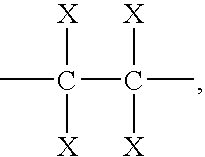Processes for synthesis of 1,3,3,3-tetrafluoropropene
a technology of tetrafluoropropene and process, which is applied in the field of tetrafluorinated propene preparation methods, can solve the problems of not disclose the specific process for the preparation of 1,3,3,3-tetrafluoropropene, no indication that the process is effective for producing 1,3,3,3-tetrafluoropropene, and the process described in this patent has the disadvantage of requiring in every case the use of methyl chlorid
- Summary
- Abstract
- Description
- Claims
- Application Information
AI Technical Summary
Benefits of technology
Problems solved by technology
Method used
Image
Examples
example 1
Synthesis of CF3CH═CFH via Reductive Coupling
[0039]CF3Br (0.25 mol) is reacted in 5 mol methanol with 0.25 mol of ClHC═CHF at a temperature of from about 15° C. to about 100° C. in the presence of about 0.005 mol of Pd / C or a mixture of about 1% to about 10% Pd and about 99% to about 90% Cu on activated carbon in an high pressure autoclave. 0.3 mol H2 gas, 0.6 mol NaOH or Na2CO3, and 0.001 mol of Tetrabutylammonium bromide are also added in to the reactor. After from about 6 to about 20 hrs of stirring at about 25° C. to about 150° C., the autoclave is cooled down and the reaction product is obtained in the form of overhead gases. The reaction product comprises CF3CH═CHF in yield of about 5-10%.
examples 2-14
[0040]The reactor used in following examples will consist of a platinum-lined tube 6 mm ID.×24 inches heated in an 8 inch (heated area 5. 5 inch) electric furnace. The product gas is analyzed by GC-MS.
example 2
[0041]A mixture of 100 mL / min CHF2Cl and 100 mL / min CF2ClCH3 is passed through the reactor described above at a contact time of about 1.19 seconds and at a temperature of about 700° C. to about 900° C. The gaseous reaction products are scrubbed free of by-product HCl and dried and analyzed by GC-MS. The scrubbed and dried product stream is found to contain 15 mole percent of tetrafluoropropenes.
PUM
| Property | Measurement | Unit |
|---|---|---|
| boiling point | aaaaa | aaaaa |
| boiling point | aaaaa | aaaaa |
| temperature | aaaaa | aaaaa |
Abstract
Description
Claims
Application Information
 Login to View More
Login to View More - R&D
- Intellectual Property
- Life Sciences
- Materials
- Tech Scout
- Unparalleled Data Quality
- Higher Quality Content
- 60% Fewer Hallucinations
Browse by: Latest US Patents, China's latest patents, Technical Efficacy Thesaurus, Application Domain, Technology Topic, Popular Technical Reports.
© 2025 PatSnap. All rights reserved.Legal|Privacy policy|Modern Slavery Act Transparency Statement|Sitemap|About US| Contact US: help@patsnap.com



